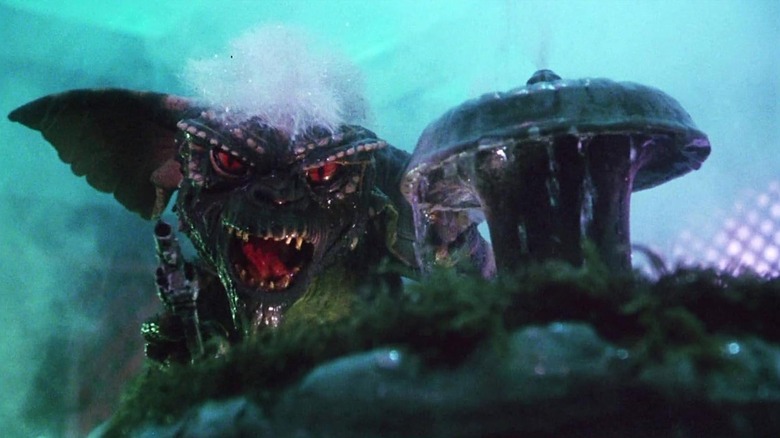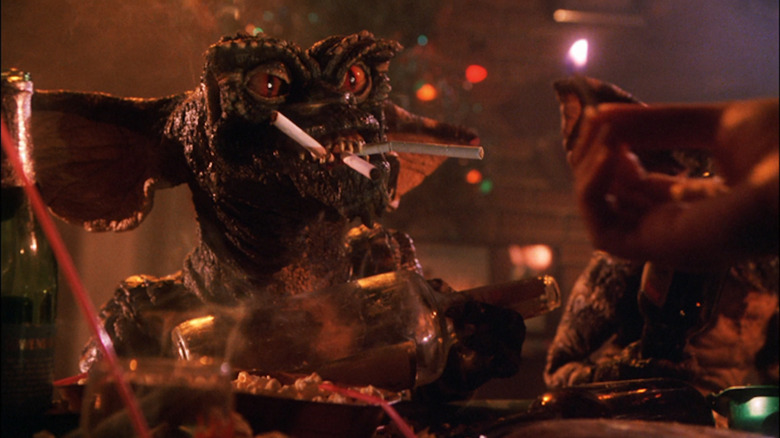A Defecating Monkey Put A Quick Stop To An Early Gremlins Design
Joe Dante's "Gremlins" is a one-of-a-kind blockbuster from an era when studios hadn't quite yet developed the formula for producing hit movies. In the early 1980s, executives under pressure to find projects capable of breaking the coveted $100 million domestic mark relied heavily on movie stars or bestselling books (especially as cover-your-ass insurance, should that big swing result in a big whiff), but to strike gold you needed vision. That meant finding a visionary.
There were two 30-something film brats who fit this profile during that period: George Lucas and Steven Spielberg. And since Lucas was, at the moment, a two-franchise man with "Star Wars" and the just-taking-off Indiana Jones series, Spielberg, who'd just set up his production company Amblin Entertainment at Universal Pictures, was the closest thing to a Walt Disney alive and unfrozen in Hollywood.
After scoring a one-two box-office knockout in 1982 with "E.T. the Extra-Terrestrial" and "Poltergeist," Spielberg was eager to expand his burgeoning showbiz empire. For his first official, producer-only Amblin project, Spielberg wanted to make a horror movie. This would be "Gremlins," a horror-comedy written by NYU grad Chris Columbus about a painfully cute mogwai that spawn other mogwai when splashed with water, but transform into hideous killer mini-beasts when fed after midnight.
Columbus' script was inventive, funny, and plenty scary. It was the ideal Amblin film, and, having sufficiently impressed Spielberg with his "Jaws" rip-off/spoof "Piranha" (and somehow avoided his wrath by nearly making the kiboshed "National Lampoon's Jaws 3, People 0" at Universal), Joe Dante was selected as the man for the gig.
Hot off the werewolf hit "The Howling," Dante knew how to make convincing monsters. What he didn't know was how to make convincingly mobile little monsters. To pull this off, he tried all sorts of crap –- and nearly got crapped on in the process.
Gremlins was a stop-motion dream deferred
Dante's first choice to bring the Gremlins to life was make-up/creature VFX maestro and his "The Howling" collaborator Rob Bottin, who'd just scored a gory, gooey coup via his wild creations for John Carpenter's "The Thing." Alas, Ridley Scott had poached Bottin for "Legend," so Dante turned to his "Piranha" make-up artist Chris Walas.
Walas had just done phenomenal work on Matthew Robbins' "Dragonslayer," and, like most of that post-"Star Wars" group of f/x wizards, seemed like a behind-the-scenes miracle worker. And he was! But he was also a practical man aware of the budget Dante had been given. $11 million wasn't chump change in 1983, but it wasn't anywhere in the ballpark of what they'd need to bring the Gremlins to life as Dante envisioned them.
While Walas was thrilled at the prospect of getting to create all kinds of nasty looking creatures, he had to wave Dante off his preferred method of moving them around. As Walas told The Ringer in a 40th anniversary oral history for the 1984 classic:
"Joe wanted to do everything stop-motion at first because he's a huge stop-motion fan, which I am as well, but I'm just like, 'Joe, do you understand how much stop-motion you're talking about?' And he did. He understood."
So, Dante did what anyone else would do in this situation: he decided to put monkeys in Gremlin suits.
Monkey see, monkey poop, monkey cut
Cinema has a rich history of monkey business: the Tarzan films of the 1930s featured the chimpanzee sidekick Cheeta; Ronald Reagan famously acted alongside a chimp in 1951's "Bedtime for Bonzo"; and, more recently, we were introduced to the rampaging Gordy in Jordan Peele's "Nope." But these were solitary characters typically played by one primate (or, in the last case, rendered via CGI).
Now imagine contending with multiple monkeys fitted into latex Gremlin outfits. Walas couldn't, and told Dante to forget it.
The director insisted on giving it a go, however, and things got messy in a jiffy. As Dante told The Ringer:
"We got a rhesus monkey and put a Gremlin's head on him, and he bounced around the editing room and s*** all over everything. And it became quite apparent that this was not the way we were going to do it."
Dante and Walas pivoted to puppets, which wound up being one of the film's (many) masterstrokes. Obviously, Gizmo is a wonder (for my money, the most adorably authentic creature ever crafted for a film), but the Gremlins are a gloriously grotesque army of anarchic monsters. Though Rick Baker wound up creating more exotic varieties for the perennially underrated "Gremlins 2: The New Batch" (a classic in its own gonzo right), Walas' set the gruesome, grinning template.
Without Walas' creative talents, "Gremlins" would've never grossed over $150 million at the North American box office in 1984, en route to becoming that summer's surprise blockbuster ("Ghostbusters" and "Indiana Jones and the Temple of the Doom" were preordained smashes), and a highly unlikely Christmas movie mainstay.


